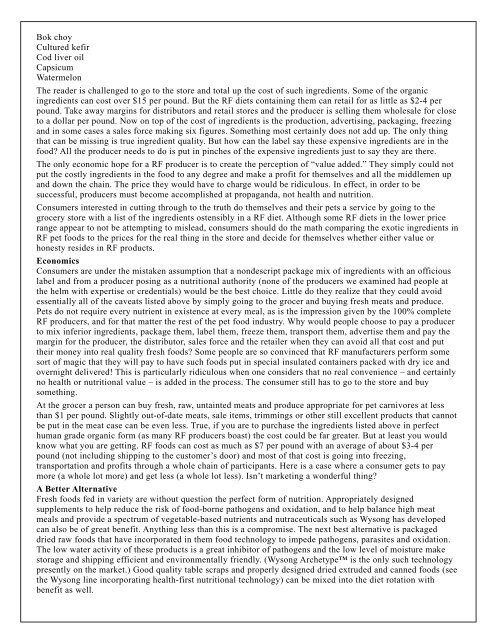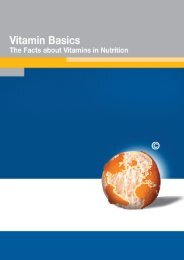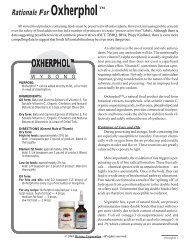Case Against Raw Frozen Pet Foods - Wysong
Case Against Raw Frozen Pet Foods - Wysong
Case Against Raw Frozen Pet Foods - Wysong
You also want an ePaper? Increase the reach of your titles
YUMPU automatically turns print PDFs into web optimized ePapers that Google loves.
Bok choy<br />
Cultured kefir<br />
Cod liver oil<br />
Capsicum<br />
Watermelon<br />
The reader is challenged to go to the store and total up the cost of such ingredients. Some of the organic<br />
ingredients can cost over $15 per pound. But the RF diets containing them can retail for as little as $2-4 per<br />
pound. Take away margins for distributors and retail stores and the producer is selling them wholesale for close<br />
to a dollar per pound. Now on top of the cost of ingredients is the production, advertising, packaging, freezing<br />
and in some cases a sales force making six figures. Something most certainly does not add up. The only thing<br />
that can be missing is true ingredient quality. But how can the label say these expensive ingredients are in the<br />
food? All the producer needs to do is put in pinches of the expensive ingredients just to say they are there.<br />
The only economic hope for a RF producer is to create the perception of “value added.” They simply could not<br />
put the costly ingredients in the food to any degree and make a profit for themselves and all the middlemen up<br />
and down the chain. The price they would have to charge would be ridiculous. In effect, in order to be<br />
successful, producers must become accomplished at propaganda, not health and nutrition.<br />
Consumers interested in cutting through to the truth do themselves and their pets a service by going to the<br />
grocery store with a list of the ingredients ostensibly in a RF diet. Although some RF diets in the lower price<br />
range appear to not be attempting to mislead, consumers should do the math comparing the exotic ingredients in<br />
RF pet foods to the prices for the real thing in the store and decide for themselves whether either value or<br />
honesty resides in RF products.<br />
Economics<br />
Consumers are under the mistaken assumption that a nondescript package mix of ingredients with an officious<br />
label and from a producer posing as a nutritional authority (none of the producers we examined had people at<br />
the helm with expertise or credentials) would be the best choice. Little do they realize that they could avoid<br />
essentially all of the caveats listed above by simply going to the grocer and buying fresh meats and produce.<br />
<strong>Pet</strong>s do not require every nutrient in existence at every meal, as is the impression given by the 100% complete<br />
RF producers, and for that matter the rest of the pet food industry. Why would people choose to pay a producer<br />
to mix inferior ingredients, package them, label them, freeze them, transport them, advertise them and pay the<br />
margin for the producer, the distributor, sales force and the retailer when they can avoid all that cost and put<br />
their money into real quality fresh foods? Some people are so convinced that RF manufacturers perform some<br />
sort of magic that they will pay to have such foods put in special insulated containers packed with dry ice and<br />
overnight delivered! This is particularly ridiculous when one considers that no real convenience – and certainly<br />
no health or nutritional value – is added in the process. The consumer still has to go to the store and buy<br />
something.<br />
At the grocer a person can buy fresh, raw, untainted meats and produce appropriate for pet carnivores at less<br />
than $1 per pound. Slightly out-of-date meats, sale items, trimmings or other still excellent products that cannot<br />
be put in the meat case can be even less. True, if you are to purchase the ingredients listed above in perfect<br />
human grade organic form (as many RF producers boast) the cost could be far greater. But at least you would<br />
know what you are getting. RF foods can cost as much as $7 per pound with an average of about $3-4 per<br />
pound (not including shipping to the customer’s door) and most of that cost is going into freezing,<br />
transportation and profits through a whole chain of participants. Here is a case where a consumer gets to pay<br />
more (a whole lot more) and get less (a whole lot less). Isn’t marketing a wonderful thing?<br />
A Better Alternative<br />
Fresh foods fed in variety are without question the perfect form of nutrition. Appropriately designed<br />
supplements to help reduce the risk of food-borne pathogens and oxidation, and to help balance high meat<br />
meals and provide a spectrum of vegetable-based nutrients and nutraceuticals such as <strong>Wysong</strong> has developed<br />
can also be of great benefit. Anything less than this is a compromise. The next best alternative is packaged<br />
dried raw foods that have incorporated in them food technology to impede pathogens, parasites and oxidation.<br />
The low water activity of these products is a great inhibitor of pathogens and the low level of moisture make<br />
storage and shipping efficient and environmentally friendly. (<strong>Wysong</strong> Archetype is the only such technology<br />
presently on the market.) Good quality table scraps and properly designed dried extruded and canned foods (see<br />
the <strong>Wysong</strong> line incorporating health-first nutritional technology) can be mixed into the diet rotation with<br />
benefit as well.




